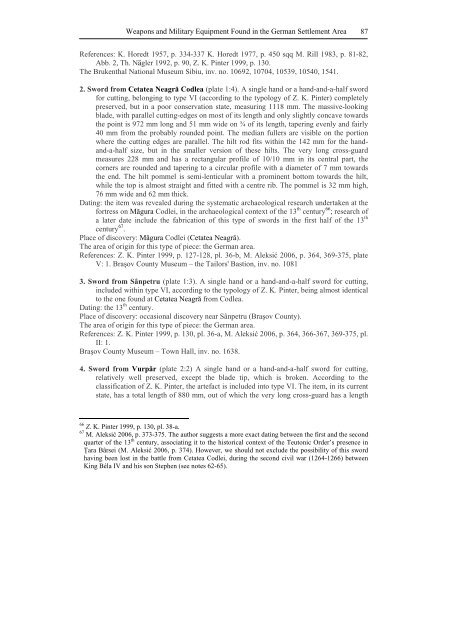Download - Facultatea de Științe Socio-Umane - Universitatea ...
Download - Facultatea de Științe Socio-Umane - Universitatea ...
Download - Facultatea de Științe Socio-Umane - Universitatea ...
You also want an ePaper? Increase the reach of your titles
YUMPU automatically turns print PDFs into web optimized ePapers that Google loves.
Weapons and Military Equipment Found in the German Settlement Area<br />
References: K. Horedt 1957, p. 334-337 K. Horedt 1977, p. 450 sqq M. Rill 1983, p. 81-82,<br />
Abb. 2, Th. Nägler 1992, p. 90, Z. K. Pinter 1999, p. 130.<br />
The Brukenthal National Museum Sibiu, inv. no. 10692, 10704, 10539, 10540, 1541.<br />
2. Sword from Cetatea Neagră Codlea (plate 1:4). A single hand or a hand-and-a-half sword<br />
for cutting, belonging to type VI (according to the typology of Z. K. Pinter) completely<br />
preserved, but in a poor conservation state, measuring 1118 mm. The massive-looking<br />
bla<strong>de</strong>, with parallel cutting-edges on most of its length and only slightly concave towards<br />
the point is 972 mm long and 51 mm wi<strong>de</strong> on ¾ of its length, tapering evenly and fairly<br />
40 mm from the probably roun<strong>de</strong>d point. The median fullers are visible on the portion<br />
where the cutting edges are parallel. The hilt rod fits within the 142 mm for the handand-a-half<br />
size, but in the smaller version of these hilts. The very long cross-guard<br />
measures 228 mm and has a rectangular profile of 10/10 mm in its central part, the<br />
corners are roun<strong>de</strong>d and tapering to a circular profile with a diameter of 7 mm towards<br />
the end. The hilt pommel is semi-lenticular with a prominent bottom towards the hilt,<br />
while the top is almost straight and fitted with a centre rib. The pommel is 32 mm high,<br />
76 mm wi<strong>de</strong> and 62 mm thick.<br />
Dating: the item was revealed during the systematic archaeological research un<strong>de</strong>rtaken at the<br />
fortress on Măgura Codlei, in the archaeological context of the 13 th century 66 ; research of<br />
a later date inclu<strong>de</strong> the fabrication of this type of swords in the first half of the 13 th<br />
century 67 .<br />
Place of discovery: Măgura Codlei (Cetatea Neagră).<br />
The area of origin for this type of piece: the German area.<br />
References: Z. K. Pinter 1999, p. 127-128, pl. 36-b, M. Aleksić 2006, p. 364, 369-375, plate<br />
V: 1. Braşov County Museum – the Tailors' Bastion, inv. no. 1081<br />
3. Sword from Sânpetru (plate 1:3). A single hand or a hand-and-a-half sword for cutting,<br />
inclu<strong>de</strong>d within type VI, according to the typology of Z. K. Pinter, being almost i<strong>de</strong>ntical<br />
to the one found at Cetatea Neagră from Codlea.<br />
Dating: the 13 th century.<br />
Place of discovery: occasional discovery near Sânpetru (Braşov County).<br />
The area of origin for this type of piece: the German area.<br />
References: Z. K. Pinter 1999, p. 130, pl. 36-a, M. Aleksić 2006, p. 364, 366-367, 369-375, pl.<br />
II: 1.<br />
Braşov County Museum – Town Hall, inv. no. 1638.<br />
4. Sword from Vurpăr (plate 2:2) A single hand or a hand-and-a-half sword for cutting,<br />
relatively well preserved, except the bla<strong>de</strong> tip, which is broken. According to the<br />
classification of Z. K. Pinter, the artefact is inclu<strong>de</strong>d into type VI. The item, in its current<br />
state, has a total length of 880 mm, out of which the very long cross-guard has a length<br />
66 Z. K. Pinter 1999, p. 130, pl. 38-a.<br />
67 M. Aleksić 2006, p. 373-375. The author suggests a more exact dating between the first and the second<br />
quarter of the 13 th century, associating it to the historical context of the Teutonic Or<strong>de</strong>r’s presence in<br />
Ţara Bârsei (M. Aleksić 2006, p. 374). However, we should not exclu<strong>de</strong> the possibility of this sword<br />
having been lost in the battle from Cetatea Codlei, during the second civil war (1264-1266) between<br />
King Béla IV and his son Stephen (see notes 62-65).<br />
87





